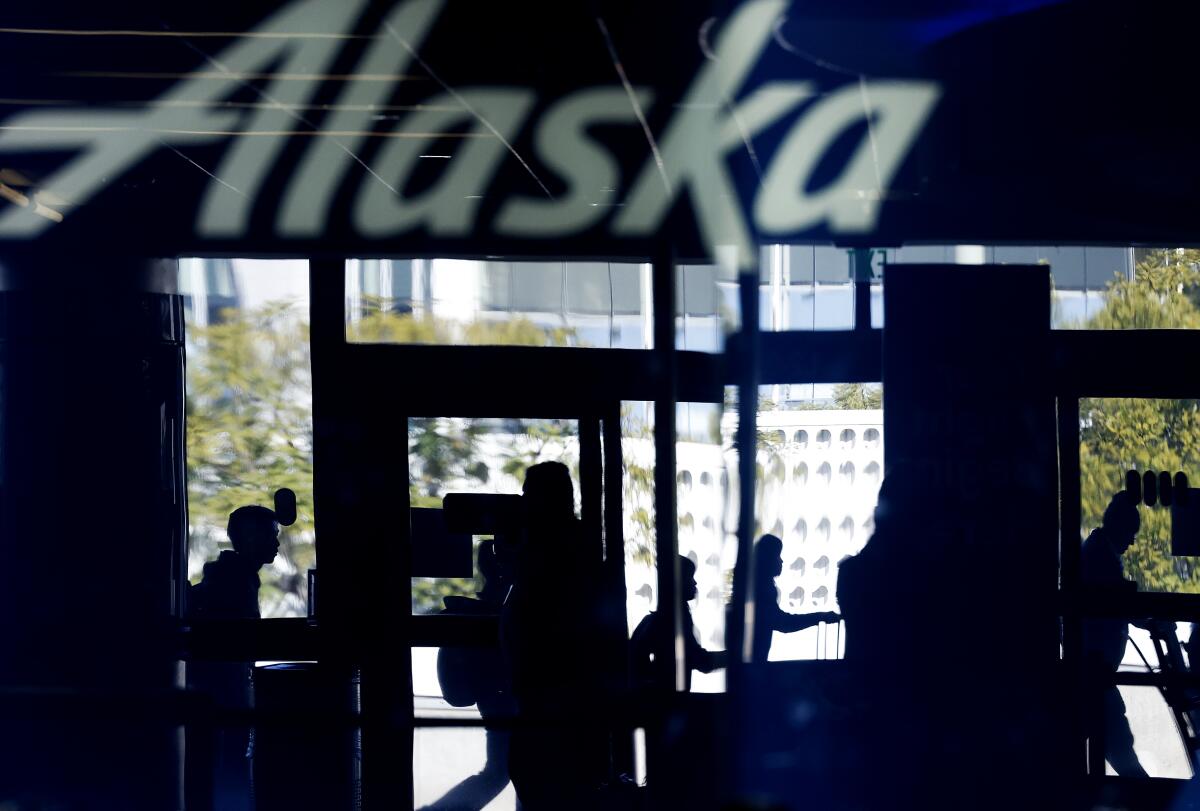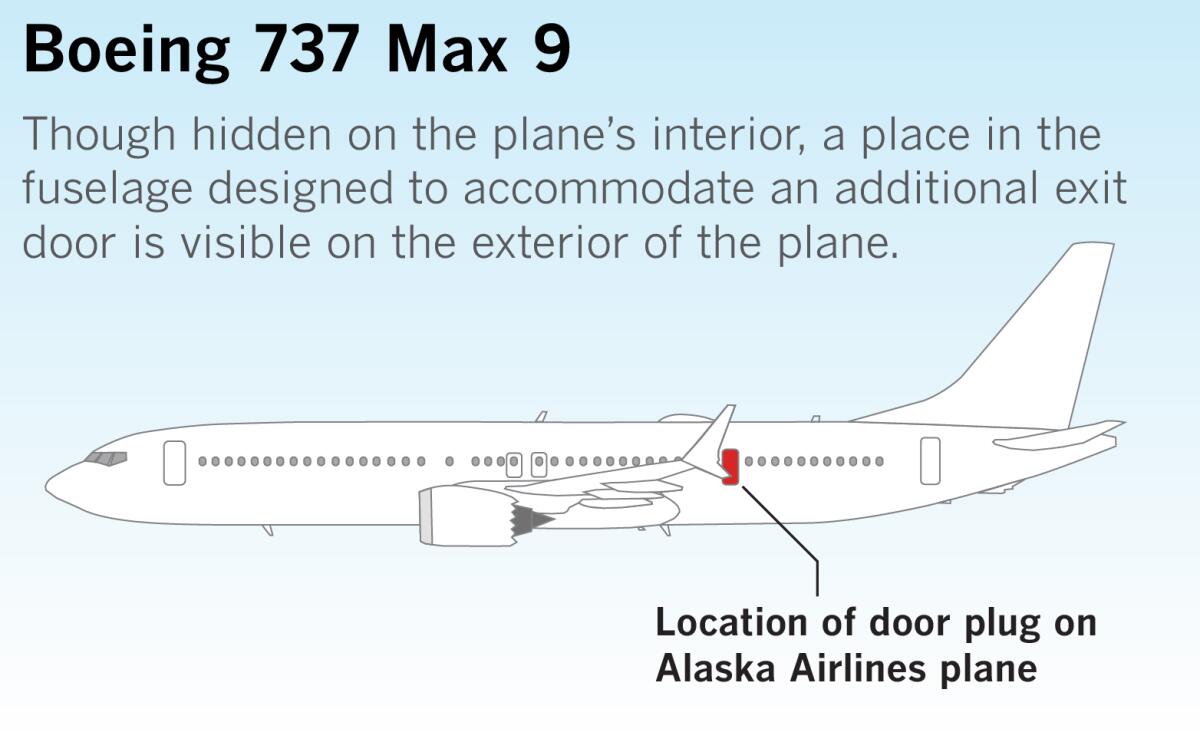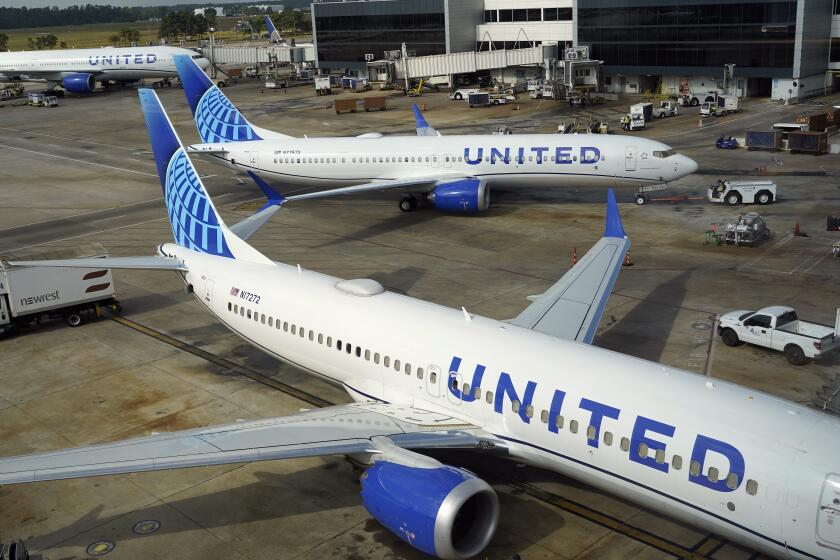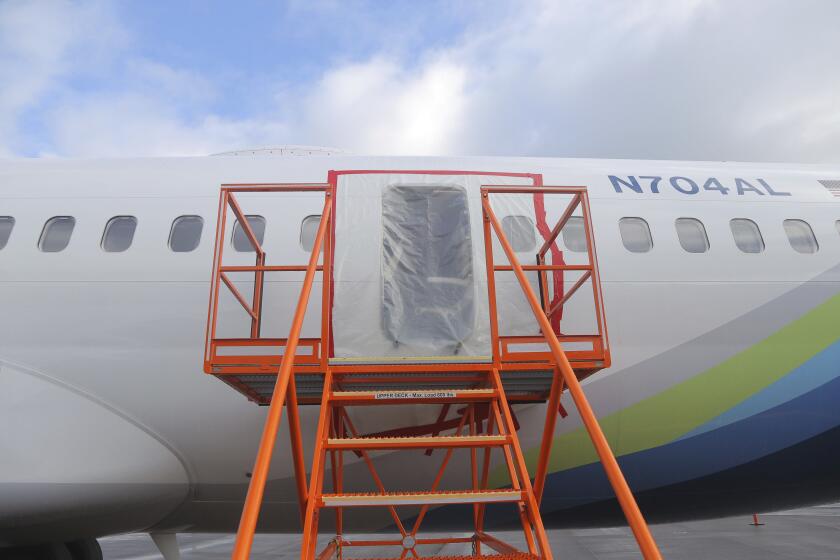How will the Boeing 737 Max 9 problem affect air travel?

- Share via
As shocking as the in-flight blowout on Alaska Airlines Flight 1282 was last week, federal officials initially estimated that the problem that caused a gaping hole to open in the plane’s fuselage would be relatively easy to diagnose and fix.
On Tuesday, though, the Federal Aviation Administration said the process will take a bit longer than anticipated. For the time being, all planes configured the same way as Flight 1282 — a recently introduced update to the extremely popular Boeing 737 — will remain grounded.
That means more travelers on United and Alaska airlines will see their flights canceled in the days to come. Here’s what we know so far about the disruption in air travel, when it might end, and what the eventual return of these planes to service might mean for fliers — especially the nervous ones.
Which airplanes are affected?
Flight 1282 was on a custom version of the Boeing 737 Max 9, the latest in a series of revisions designed to enlarge the 737s so they could carry more passengers, and generate more revenue. The Max 9s are almost 9 feet longer than the 737 Max 8s that came out a few years previously, and when they carry the full complement of seats, they require an extra emergency exit between the wings and the tail.

The number of emergency exits required depends on the number of seats, said Robert L. Ditchey, an aviation consultant based in Marina del Rey. But a few airlines ordered a modified version of the Max 9 with fewer seats, dispensing with the need for the extra exits. That means fewer potential tickets sold, but also less maintenance costs associated with the emergency door and the exit slide, he said.
Rather than creating a new fuselage for the alternate version, Boeing used the same one but plugged the holes for the two extra emergency exits with a plate that’s bolted to the frame. That’s the part — known as the door plug — that blew off on Flight 1282 when the plane’s interior was pressurized.
Alaska and United airlines have found problems with door plugs on their Boeing 737 Max 9 jets after the blowout of the same piece of fuselage on an Alaska flight.
Which airlines have the grounded planes?
Boeing won’t disclose its customer list, but Alaska and United Airlines are the only domestic carriers that have been publicly identified as having the modified 737 Max 9s. United says it has 79 Max 9s, and Alaska says it has 65.
The aviation website flightradar24 named three foreign airlines that are operating Max 9s with door plugs — Copa Airlines, Aeromexico and Turkish Airlines.
The FAA, whose authority extends only to U.S. airlines, says that it ordered 171 planes to be grounded. That represents a small percentage of all the aircraft in service in the United States. Nevertheless, neither Alaska nor United has enough planes to cover all the flights that were scheduled to be handled by their Max 9s, forcing well over 200 cancellations daily.
United said it was canceling 170 flights on Tuesday and redeploying other planes to replace Max 9s on 45 others. Alaska said that it had canceled 109 flights as of 12:30 on Tuesday.
How long will the planes be grounded?
Nothing is certain at this point, but Alaska Airlines said Wednesday that it was canceling all flights on 737 Max 9s through Saturday, Jan. 13.
The FAA’s emergency airworthiness directive set up a process by which the affected planes can be returned to service. The planes would be inspected by the airlines following FAA guidelines, and they’d take whatever corrective actions were required. The inspections would take only four to eight hours per plane, the agency estimated on Saturday.
This is standard operating procedure for the FAA, which doesn’t have the personnel to do inspections itself, Ditchey said. Instead, it leaves the job to certified technicians working for the airlines.
The holdup here is getting to the point where the inspections can begin.
On Tuesday, the FAA said on X.com (formerly Twitter) that the process had to start with Boeing providing instructions to the airlines for how to inspect and maintain the plugs. “Boeing offered an initial version of instructions yesterday which they are now revising because of feedback received in response,” the agency said. “Upon receiving the revised version of instructions from Boeing the FAA will conduct a thorough review.”
“The safety of the flying public, not speed, will determine the timeline for returning the Boeing 737-9 Max to service,” the FAA said.
What’s a ‘door plug’ and why do airliners have them? How does a smartphone still work after falling three miles? We have answers to these and other questions stemming from Alaska Flight 1282.
Industry analyst Bob Mann said the revised instructions probably relate to what the airlines found when they started examining the plugs in preparation for the inspections. “Most of maintenance is like that — you go in there looking for one thing and you find three things,” he said.
Just how long the work will take depends on what sort of issues are uncovered, Mann said. For example, it could be a matter of tightening the existing fasteners better, or it might require a different type of fastener.
Still, analysts predicted that the planes would be back in service within two weeks. “Nothing I’ve heard so far rises to the level of, ‘We want to redesign this,’” Mann said.
How can I tell if the flight I’ve booked will be affected?
The short answer is that you can’t tell for sure because the airlines can deploy new planes to routes after you buy your ticket. But if you go to the airline’s website, you can see what kind of plane is assigned to your route now. One thing to bear in mind is that the grounded airplane is a 737 Max 9, not a 737-900. The names are similar, but the latter is an older plane that was part of a previous series of updates by Boeing.
What if my flight gets canceled?
With some restrictions, Alaska is allowing passengers to rebook their flights for free, and in some cases to cancel their flights for a future credit. United is allowing free rebooking for passengers on affected flights too, but also full refunds.
Paul Hudson, founder of the airline passenger advocacy group flyersrights.org, said that passengers on canceled flights are entitled to their money back. “You have an absolute right to a ticket refund. You don’t have to accept a voucher or a later flight,” Hudson said.
Granted, a refund for a ticket you bought well in advance isn’t likely to cover the cost of a flight booked at the last minute. And airlines are under no obligation to offer you an alternative flight on the same day, or to offer you a hotel room if you’re forced to stay away from home overnight when traveling within the U.S., Hudson said. Those sorts of accommodations are governed by each airline’s policies.
Hudson said that, given how many flights are being canceled even when planes aren’t grounded, travelers should always have a backup plan. One way to do that, he said, is to have a second, fully refundable ticket on a different airline to get you to your destination in case the first flight you reserved gets axed.
Other suggestions are to build in an extra travel day, book nonstop flights to avoid being stranded midway to your destination, and to book flights that take off in the morning, Hudson said. “Because if your flight is canceled or delayed, you have time to make other arrangements,” he said.
Alaska Airlines Flight 1282 from Portland, Ore., to Ontario in Southern California made an emergency landing after a window and part of the plane’s wall blew out, social media reports said.
Should I be worried about flying Max 9s in the future?
The Max series hasn’t enjoyed much of a honeymoon. After the Max 8 planes were introduced, problems with an automated flight control system caused two planes to crash in Indonesia and Ethiopia, killing 346 people and leading regulators around the world to ground the planes for at least 20 months. Those planes have been back in service in the U.S. for about four years. “Once [the Max 8] was back, it’s done exactly what it was supposed to do,” Mann said. The same flight control system is in the rest of the Max models.
Ditchey argued that the issue with the Max 9s requires a structural change, not merely stronger fasteners. That’s because of the stress caused by the difference in air pressure inside and outside a plane.
Airlines pressurize their interiors as they climb because there’s not enough oxygen to support life in the thinner atmosphere at higher altitudes. But if a hole suddenly opens in the fuselage when a plane is high above the earth, the higher pressure inside can force people and objects to be expelled from the plane.
(On that score, it was a good thing Flight 1282 had its blowout shortly after takeoff, when it was at 16,000 feet instead of 30,000, and that no one was sitting in the seat next to the plug. “If you have a big hole and someone’s sitting next to that hole and they’re not wearing a safety belt … color them gone,” said Barry Schiff, an aviation safety consultant.)
Ditchey said that emergency doors, like the regular doors on a plane, are bigger than the opening in the fuselage they fit into, so the interior pressure binds them more strongly to the frame. The plug, however, has no such “failsafe.” A true fix, he said, would require designing the plug with a failsafe like the emergency doors.
Mann disagreed, saying if the plug is attached properly, it should transfer the stress of pressurization adequately to the fuselage.
Hudson said that after the Max 8s returned to service, the airlines offered penalty-free flight changes to any passenger who didn’t want to fly on one of those planes. “That’s all gone away now,” he said.
Whether the airlines will take a similar tack with the Max 9s, he said, “depends on public pressure.”
More to Read
Sign up for Essential California
The most important California stories and recommendations in your inbox every morning.
You may occasionally receive promotional content from the Los Angeles Times.














